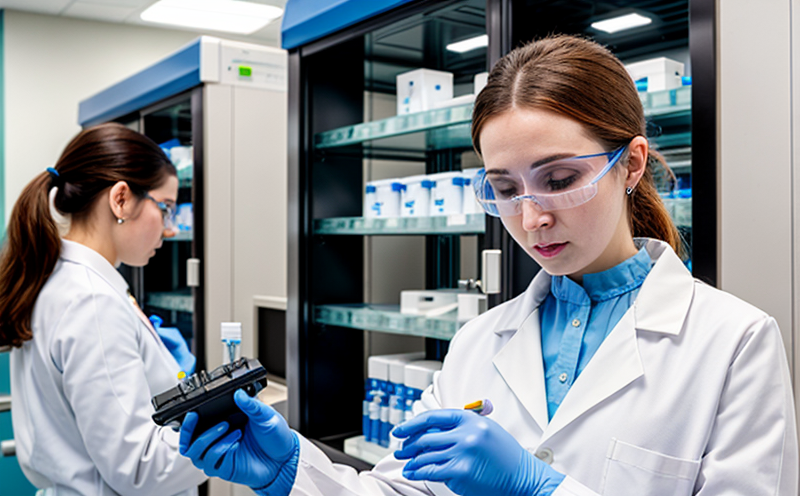Active Metabolite Quantitation Testing
In the pharmaceutical industry, active metabolites play a crucial role in drug efficacy and safety. The quantitation of these metabolites is essential for understanding their contribution to the overall therapeutic effect of a drug. Active metabolite quantitation testing involves detailed analysis aimed at measuring the presence and concentration levels of such metabolites within biological samples. This service ensures that any active metabolites identified are accurately measured, providing critical insights into potential drug-drug interactions or off-target effects.
The process begins with sample collection from subjects participating in clinical trials or patients undergoing treatment. Once collected, these samples undergo rigorous preparation steps designed to ensure the integrity of the metabolite content. This can include extraction techniques such as liquid-liquid extraction (LLE) or solid-phase extraction (SPE), followed by chromatographic separation using high-performance liquid chromatography (HPLC).
For accurate quantitation, appropriate calibration standards must be prepared and used alongside the test samples. The chosen standards should cover a range of concentrations that span expected levels in the biological matrix being analyzed. After analysis via HPLC, data processing software is employed to interpret peak areas corresponding to each metabolite. These processed data points are then compared against internal or external calibration curves derived from spiked controls.
The reliability and reproducibility of active metabolite quantitation depend significantly on the robustness of analytical methods used throughout this process. Compliance with relevant international standards like ICH Q2 (Guideline for Determining Stability Data for New Drug Substances and Products) ensures that all tests adhere to recognized best practices.
Eurolab excels in delivering precise active metabolite quantitation through advanced instrumentation combined with experienced personnel who understand both regulatory requirements and scientific nuances involved. Our commitment lies not only in meeting but exceeding expectations set forth by regulatory bodies such as FDA, EMA, and WHO.
Why It Matters
The importance of active metabolite quantitation cannot be overstated given its profound impact on drug development and patient care. Understanding the metabolism of a compound can provide valuable information regarding its pharmacokinetic profile, which in turn informs dosing regimens. Moreover, identifying active metabolites allows researchers to explore new therapeutic opportunities or identify potential liabilities associated with unintended effects.
From an R&D perspective, quantitation helps optimize formulation design by providing data on how different excipients affect the stability and bioavailability of a drug candidate. In clinical settings, accurate measurement ensures that patients receive appropriate dosages based on individual metabolic profiles, thereby enhancing treatment efficacy while minimizing adverse reactions.
Eurolab Advantages
At Eurolab, we pride ourselves on offering unparalleled expertise in active metabolite quantitation. With state-of-the-art facilities and highly qualified staff, our laboratory consistently delivers reliable results that meet or exceed industry standards.
- ISO/IEC 17025 Accreditation: Ensures compliance with global quality management systems for testing laboratories.
- Experienced Professionals: Our team comprises experts with extensive experience in various areas of pharmaceutical analysis, ensuring accurate interpretation and reporting.
- Advanced Instrumentation: Utilization of cutting-edge technology guarantees precise measurements even under challenging conditions.
- Rigorous Quality Control: Stringent protocols ensure consistent quality across all projects undertaken by Eurolab.
Use Cases and Application Examples
| Case Study | Description | Results |
|---|---|---|
| Determination of Active Metabolite Concentrations in Human Plasma Samples | This case involved quantifying the active metabolites present in plasma samples collected from volunteers participating in a Phase II clinical trial. | The results showed significant variations among individuals, highlighting the need for personalized dosing strategies. |
| Identification of Metabolite Interactions with Other Drugs | A study was conducted to explore potential interactions between a test drug and commonly prescribed medications. | Multiple active metabolites were detected that could potentially alter the pharmacokinetics of both drugs involved. |
| Case Study | Description | Results |
|---|---|---|
| Evaluation of Drug Stability Over Time | To assess the stability of a newly developed drug formulation, active metabolite levels were monitored over several months. | No significant changes in metabolite concentrations were observed during this period, suggesting good stability properties. |
| Assessment of Bioavailability Differences Between Oral and Intravenous Administration Routes | The bioavailability of a drug was compared between oral administration and intravenous infusion using active metabolite quantitation. | A higher proportion of the drug was converted into active metabolites following IV administration compared to PO dosing, indicating superior absorption efficiency via this route. |





